
In botany, apical dominance is the phenomenon whereby the main, central stem of the plant is dominant over other side stems; on a branch the main stem of the branch is further dominant over its own side twigs.
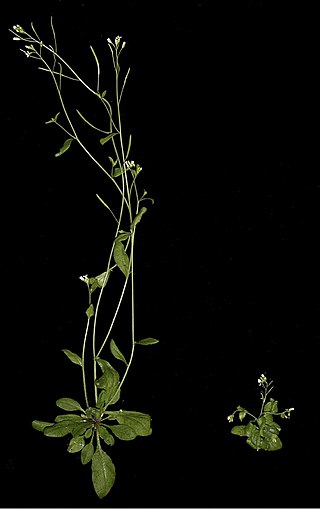
Plant hormones are signal molecules, produced within plants, that occur in extremely low concentrations. Plant hormones control all aspects of plant growth and development, including embryogenesis, the regulation of organ size, pathogen defense, stress tolerance and reproductive development. Unlike in animals each plant cell is capable of producing hormones. Went and Thimann coined the term "phytohormone" and used it in the title of their 1937 book.
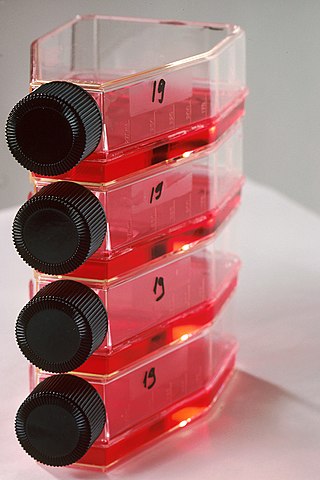
Tissue culture is the growth of tissues or cells in an artificial medium separate from the parent organism. This technique is also called micropropagation. This is typically facilitated via use of a liquid, semi-solid, or solid growth medium, such as broth or agar. Tissue culture commonly refers to the culture of animal cells and tissues, with the more specific term plant tissue culture being used for plants. The term "tissue culture" was coined by American pathologist Montrose Thomas Burrows. This is possible only in certain conditions. It also requires more attention. It can be done only in genetic labs with various chemicals.

Auxins are a class of plant hormones with some morphogen-like characteristics. Auxins play a cardinal role in coordination of many growth and behavioral processes in plant life cycles and are essential for plant body development. The Dutch biologist Frits Warmolt Went first described auxins and their role in plant growth in the 1920s. Kenneth V. Thimann became the first to isolate one of these phytohormones and to determine its chemical structure as indole-3-acetic acid (IAA). Went and Thimann co-authored a book on plant hormones, Phytohormones, in 1937.
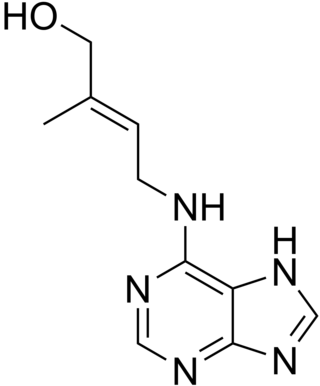
Cytokinins (CK) are a class of plant hormones that promote cell division, or cytokinesis, in plant roots and shoots. They are involved primarily in cell growth and differentiation, but also affect apical dominance, axillary bud growth, and leaf senescence.
Organogenesis is the phase of embryonic development that starts at the end of gastrulation and continues until birth. During organogenesis, the three germ layers formed from gastrulation form the internal organs of the organism.
Plant embryonic development, also plant embryogenesis is a process that occurs after the fertilization of an ovule to produce a fully developed plant embryo. This is a pertinent stage in the plant life cycle that is followed by dormancy and germination. The zygote produced after fertilization must undergo various cellular divisions and differentiations to become a mature embryo. An end stage embryo has five major components including the shoot apical meristem, hypocotyl, root meristem, root cap, and cotyledons. Unlike the embryonic development in animals, and specifically in humans, plant embryonic development results in an immature form of the plant, lacking most structures like leaves, stems, and reproductive structures. However, both plants and animals including humans, pass through a phylotypic stage that evolved independently and that causes a developmental constraint limiting morphological diversification.
Somaclonal variation is the variation seen in plants that have been produced by plant tissue culture. Chromosomal rearrangements are an important source of this variation. The term somaclonal variation is a phenomenon of broad taxonomic occurrence, reported for species of different ploidy levels, and for outcrossing and inbreeding, vegetatively and seed propagated, and cultivated and non-cultivated plants. Characters affected include both qualitative and quantitative traits.
Kinetin (/'kaɪnɪtɪn/) is a cytokinin-like synthetic plant hormone that promotes cell division in plants. Kinetin was originally isolated by Carlos O. Miller and Skoog et al. as a compound from autoclaved herring sperm DNA that had cell division-promoting activity. It was given the name kinetin because of its ability to induce cell division, provided that auxin was present in the medium. Kinetin is often used in plant tissue culture to induce callus formation and regenerate shoot tissues from callus.
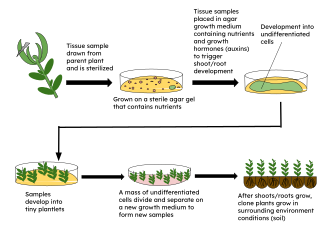
Micropropagation or tissue culture is the practice of rapidly multiplying plant stock material to produce many progeny plants, using modern plant tissue culture methods.

Indole-3-butyric acid (1H-indole-3-butanoic acid, IBA) is a white to light-yellow crystalline solid, with the molecular formula C12H13NO2. It melts at 125 °C in atmospheric pressure and decomposes before boiling. IBA is a plant hormone in the auxin family and is an ingredient in many commercial horticultural plant rooting products.

Folke Karl Skoog was a Swedish-born American plant physiologist who was a pioneer in the field of plant growth regulators, particularly cytokinins. Skoog was a recipient of the National Medal of Science 1991.
In biology, explant culture is a technique to organotypically culture cells from a piece or pieces of tissue or organ removed from a plant or animal. The term explant can be applied to samples obtained from any part of the organism. The extraction process is extensively sterilized, and the culture can be typically used for two to three weeks.
Embryomics is the identification, characterization and study of the diverse cell types which arise during embryogenesis, especially as this relates to the location and developmental history of cells in the embryo. Cell type may be determined according to several criteria: location in the developing embryo, gene expression as indicated by protein and nucleic acid markers and surface antigens, and also position on the embryogenic tree.
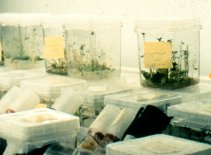
Plant tissue culture is a collection of techniques used to maintain or grow plant cells, tissues, or organs under sterile conditions on a nutrient culture medium of known composition. It is widely used to produce clones of a plant in a method known as micropropagation. Different techniques in plant tissue culture may offer certain advantages over traditional methods of propagation, including:
Embryo rescue is one of the earliest and successful forms of in-vitro culture techniques that is used to assist in the development of plant embryos that might not survive to become viable plants. Embryo rescue plays an important role in modern plant breeding, allowing the development of many interspecific and intergeneric food and ornamental plant crop hybrids. This technique nurtures the immature or weak embryo, thus allowing it the chance to survive. Plant embryos are multicellular structures that have the potential to develop into a new plant. The most widely used embryo rescue procedure is referred to as embryo culture, and involves excising plant embryos and placing them onto media culture. Embryo rescue is most often used to create interspecific and intergeneric crosses that would normally produce seeds which are aborted. Interspecific incompatibility in plants can occur for many reasons, but most often embryo abortion occurs In plant breeding, wide hybridization crosses can result in small shrunken seeds which indicate that fertilization has occurred, however the seed fails to develop. Many times, remote hybridizations will fail to undergo normal sexual reproduction, thus embryo rescue can assist in circumventing this problem.
Hyperhydricity is a physiological malformation that results in excessive hydration, low lignification, impaired stomatal function and reduced mechanical strength of tissue culture-generated plants. The consequence is poor regeneration of such plants without intensive greenhouse acclimation for outdoor growth. Additionally, it may also lead to leaf-tip and bud necrosis in some cases, which often leads to loss of apical dominance in the shoots. In general, the main symptom of hyperhydricity is translucent characteristics signified by a shortage of chlorophyll and high water content. Specifically, the presence of a thin or absent cuticular layer, reduced number of palisade cells, irregular stomata, less developed cell wall and large intracellular spaces in the mesophyll cell layer have been described as some of the anatomic changes associated with hyperhydricity.

Somatic embryogenesis is an artificial process in which a plant or embryo is derived from a single somatic cell. Somatic embryos are formed from plant cells that are not normally involved in the development of embryos, i.e. ordinary plant tissue. No endosperm or seed coat is formed around a somatic embryo.
Maryam Jafarkhani Kermani is an Associate Professor in the Department of Tissue and Cell Culture at the Administration of Agriculture and Biotechnology Research Institute of Iran (ABRII). She is an Iranian scientist whose main research area is agricultural tissue culture and mainly studies plants in the Rosaceous family.












